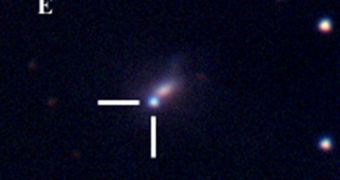Supernovae are the huge explosions that accompany the end of a massive star's burning cycle. When the detonations occur, the outer layers over the former core are violently thrown away, and the core itself may collapse into a black hole, or into a neutron star, or simply a small, helium-based star, known as a white dwarf. In precisely this type of celestial bodies, long thought to be essentially uninteresting, astronomers have recently discovered a new type of supernova. In this instance, they explain, the helium on the surface of the white dwarf simply detonates, Space reports.
Oddly enough, this type of stellar explosion was first identified more than seven years ago by amateur astronomers, in the galaxy NGC 1821. However, at the time, the detonation was classified erroneously as a Type II supernova. The exploding star, known among astronomers by the catchy name of SN2002bj, had a different signature than either Type I or Type II supernovae. One of the first clues of it being different was derived from the fact that it brightened and dimmed over the course of 27 days, whereas most such formations take between three and four months to do that.
“This is the fastest evolving supernova we have ever seen,” explains Dovi Poznanski. He is an astronomer at the US Department of Energy's (DOE) Lawrence Berkeley National Laboratory (Berkeley Lab). The expert managed to make the observations, and rediscover the peculiar exploding star, as he was browsing through old observation files. Studies have determined that the explosions which shook SN2002bj were at least 1,000 times more powerful than the average nova explosion. The new type of stars have been dubbed “.Ia” supernovae, because they are just 10 percent the brightness and duration of normal, Type 1a explosions.
University of California in Santa Barbara (UCSB) expert Lars Bildsten first proposed the mechanism that is now widely believed to have been at work for creating the new class of supernovae. Experts now believe that these explosions appeared in a binary white dwarf system, in which one of the star drew helium from the other. When sufficient quantities built up, the explosion – a short thermo-nuclear reaction – occurred. Astronomers compare this mechanism to the one at work in stars going nova, which attract hydrogen until the large concentrations of the stuff explode.

 14 DAY TRIAL //
14 DAY TRIAL //